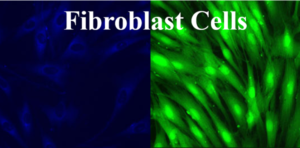Fibroblasts are the cells that make up the structural framework or stroma composed of the extracellular matrix and collagen in animal tissues. Fibroblasts the most common type of connective tissue in animals and they significantly contribute to several physiological processes, which include the following:
- Synthesis of extracellular matrix (ECM)
- Epithelial differentiation
- Regulation of inflammation
- Wound healing
Fibroblasts also secrete a variety of matrix proteins and biochemical mediators, such as proteases and growth factors, acting as mediator cells for tissue fibrosis and scar formation. Human fibroblast lines taken from biopsies of patients have been used to explain the pathogenesis of several diseases. Fibroblast transfection is a commonly used method in molecular and cell biology research, and fibroblast transfection reagents are commercially available for both fibroblast cell lines and primary cells. A fibroblast cell has a flat, elongated morphology with multiple processes emerging from the cell body, creating the spindle-like appearance depicted in the image below.

Copyright picture from altogen.com. Reproduced with permission from Altogen Biosystems.
Origin
Fibroblasts were first described in the late nineteenth century and are derived from primitive mesenchyme, like all other connective tissue cells. The ability of fibroblasts to express the filament protein vimentin alludes to their mesodermal origin.
Connective Tissue
Connective tissue is one of the four main types of tissue in the body. The others are epithelial, muscle and nervous tissue. Connective tissue is a fibrous tissue that lies between other tissues and is made largely of collagen, the most abundant protein in mammals. The connective-tissue family includes fibroblasts, bone, cartilage, muscle, fat, blood, and embryonic tissue cells. Connective tissue can be either loose or dense, depending on how the fibers within the tissue are arranged.
Fibroblasts are spread throughout connective tissues, where they secrete a collagen-rich extracellular matrix. When a tissue is injured, nearby fibroblasts migrate to the wound to isolate and repair the tissue by synthesizing large amounts of collagen on site. Fibroblasts also tend to exhibit the most versatility among the connective-tissue family, as they are able to convert into different functional connective-tissue cells, depending on the components of the extracellular matrix.
Fibroblasts and the Extracellular Matrix
Dense connective tissue is used to form ligaments and tendons. Ligaments are rope-like tissue bundles that attach bones to each other and are found in joints whereas tendons attach bones to the surrounding skeletal muscle tissue. Dense connective tissue also makes up the dermis. The tissue matrix is made almost entirely of collagen, which is the most abundant protein in mammals. Interspersed between the collagen fibers of dense connective tissue are fibroblasts which produce a collagen subunit, tropocollagen, used to construct larger collagenous aggregates.
Fibroblasts also produce glycoproteins and polysaccharides for the ground substances, a gel-like material that surrounds collagen fibers of dense connective tissue. This forms an “extracellular matrix” which contributes to the structural integrity of ligaments and tendons and determines the physical properties of connective tissue.
The extracellular matrix (ECM) is composed of a complex network of fiber-forming structural molecules, nonfiber structural molecules, and matricellular proteins that modify cell-matrix interactions. Fiber-forming structural molecules, such as collagen, contribute to the mechanical structure of the ECM by synthesizing a complex framework of rigid proteins. Nonfiber structural molecules, such as proteoglycans and glycosaminoglycans (GAGs), are responsible for creating a charged and osmotically active interstitial space. Matricellular proteins do not necessarily contribute to the mechanical structure of the extracellular matrix but instead act as cell signaling molecules.
In addition, fibroblasts have a tissue repair function and wounds stimulate fibroblast production. Collagen’s ubiquity makes fibroblasts the most common cells of connective tissue in mammals. The extracellular matrix plays a crucial role in tissue activity and wound healing, capable of influencing the migration and gene expression of a fibroblast. The ECM is also able to differentiate a fibroblast into other functional cell types. In a healing wound, a fibroblast produces the components of the extracellular matrix. The same molecules from the ECM then simultaneously work to modify the function of the fibroblast, depending on its location in the body.
Overall, the components of the extracellular matrix greatly contribute to the survival, migration, and metabolism of fibroblasts.
Fibroblasts and Fibrocytes
Fibroblasts come in various shapes and sizes, as well as in an activated and non-activated form. Fibroblasts are the activated form (the suffix “blast” refers to a metabolically active cell), while fibrocytes are considered less active. However, sometimes both fibroblasts and fibrocytes are not designated as being different and are simply referred to as fibroblasts. Morphologically, fibroblasts can be distinguished from fibrocytes by their abundance of rough endoplasmic reticulum and relatively larger size.
Links
Generation of Stably Expressing Fibroblast Cell Lines in 28 Days
Fibroblast (Encyclopedia Brittanica)
siRNA Delivery – In Vivo Transfection Kits
CRO Pre-clinical Research Services: Xenograft animal models
Encapsulation of Protein, RNA, mRNA, and DNA Molecules into Liposomes
Fibroblast Cells L
Fibroblast Cell │ Culture Protocol │ Fibroblast Transfection Information